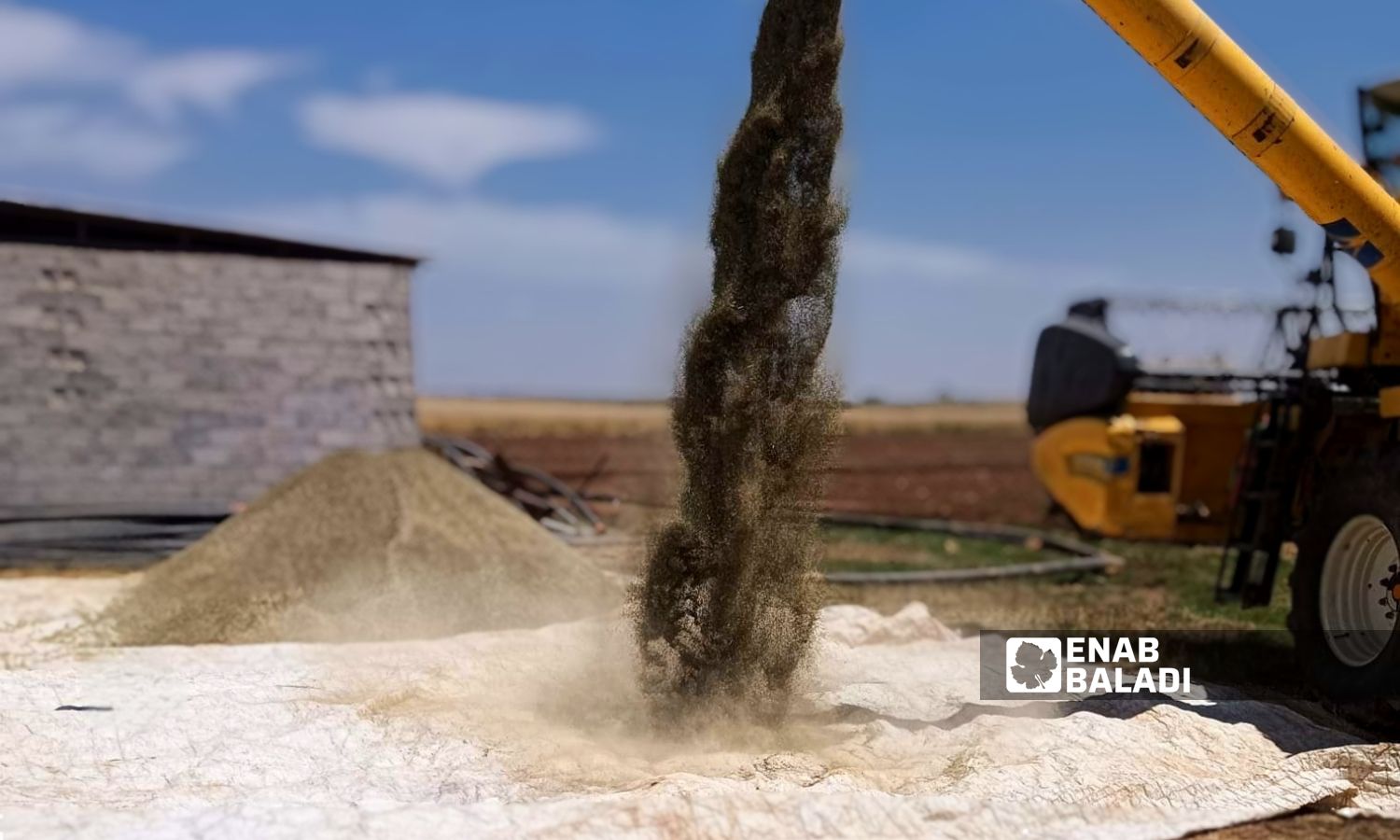



Enab Baladi – Ras al-Ain
The suffering of cumin farmers in the city of Ras al-Ain northwest of al-Hasakah continues this season, following rainfall that destroyed 65% of the crop, resulting in low prices that do not compensate for the damage but rather deepen the losses.
The problem currently lies in the decrease in the price of a kilogram of cumin from $12 to $3, the control traders have over the price, and the absence of mechanisms for marketing the crop.
Enab Baladi obtained a list of cumin prices in the area: the price for a kilo of cleaned Syrian cumin, also known as “zero”, is $3, uncleaned Syrian cumin is $2, and newly cultivated Turkish cumin in the area is also $3 for cleaned cumin and between $2 and $2.5 for uncleaned cumin of unknown origin.
Cumin planting in the area begins in mid-November and extends until December, while the harvest period starts at the beginning of May each year.
The Syrian Interim Government (SIG) does not support the marketing of agricultural crops in Ras al-Ain and Tel Abyad, leaving crop pricing to the traders who buy them at prices that do not even cover the farmers’ costs.
Enab Baladi spoke to several farmers who complained about the stagnation of the cumin crop and the “inappropriate” prices set by traders, which do not allow any chance for farmers to earn reasonable profits.
Abdullah al-Sattam, a farmer from Alouk village west of Ras al-Ain, told Enab Baladi that he had planted 130 dunams of cumin this year, hoping to compensate for the losses incurred in previous seasons, including wheat and cotton crops.
He added that after harvesting, and due to 85% of his crop being damaged, production did not exceed 15 kilograms per dunam, which does not cover the cost of the medicine he used to treat the cumin from diseases.
He mentioned that his losses increased after selling the cumin in the market, as traders did not offer more than $2.25 per kilogram, despite his crop being of first-grade quality known as “zero”, and he pointed out that he had put his house and tractor up for sale to compensate for the losses.
Marai Zarqan from al-Salihiyah village west of Ras al-Ain planted cumin on an area estimated at 40 dunams, but production did not exceed 20 kilograms per dunam, which was also not enough to cover the costs, he said.
He added that traders offered him only $2 per kilogram and expressed his anger at the situation farmers have reached, indicating that he decided to stop farming altogether as it no longer provides a decent living.
Farmers called on the Interim Government to find solutions to this “unacceptable” situation and to fulfill its commitments towards the farmers.
Ras al-Ain and Tel Abyad are located along the Turkish border, controlled by the Turkish-backed Syrian National Army (SNA), surrounded by fronts with the Syrian Democratic Forces (SDF), and the Turkish border is their only outlet to the outside.
Malik al-Na’imi, owner of an agricultural trade company, told Enab Baladi that the low prices of cumin and other agricultural crops are due to the narrow geographical area and the difficulty of export.
He explained that traders used to export cumin and aromatic plants to the interior of Syria due to their medical and therapeutic uses.
He added that the process of exporting from Syria to Turkey, and then from Turkey to countries like Iraq or others, requires long and sometimes difficult procedures due to the regulations of each country, which necessitates long waits and imposes high transport and customs clearance costs.
He pointed out that traders’ profits are much less than what the locals expect, leaving them with a profit margin not exceeding 5% per ton currently.
In a previous statement to Enab Baladi, Omar Hammoud, head of the agricultural office in the local council, said that the damage to land planted with cumin this year reached more than 65% of the planted area, which is about 60 thousand dunams.
He added that climate change and heavy rainfall led to significant damage to this crop, causing it to be affected by several diseases, the most important of which is wilting that affects the plant at the beginning and leads to its complete death, in addition to the blight disease that affected cumin in its advanced stages, causing root death.
He explained that cumin cultivation succeeded in 2023 because the climatic conditions were suitable for it, being a sensitive plant.
Agriculture, alongside livestock breeding, is one of the main professions for most residents of Ras al-Ain and areas in northern and northeastern Syria, forming a primary source of income in these regions.
Turkey manages the cities of Ras al-Ain and Tel Abyad in northern Syria, and service institutions in these areas are run through the center of Urfa Province in Turkey, with the local council supervising the implementation of service projects, which are modest compared to those carried out in northern Aleppo province.
if you think the article contain wrong information or you have additional details Send Correction